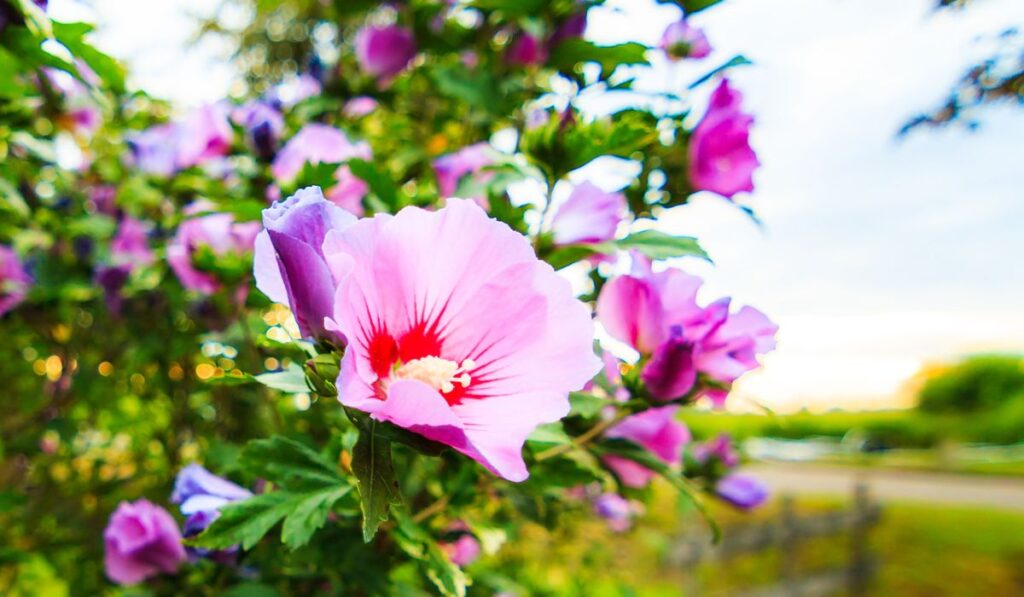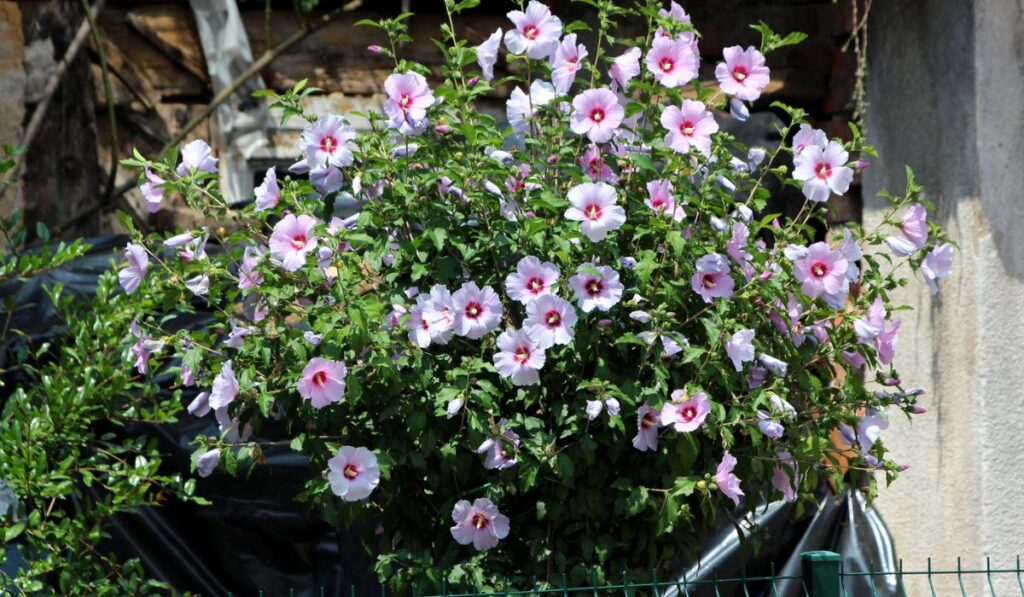Rose of Sharon evokes a sensual tropical look and adds bold visual interest to your garden. This hardy shrub has dazzling flowers that bloom from mid-summer into fall when most plants are finished for the season. So, how do you plant and care for it?
Plant Rose of Sharon by digging a deep hole that’s twice as deep as the root ball. Remove the plant from its nursery pot and place it in the hole. Backfill the hole, water the plant well, and add a layer of mulch. Rose of Sharon requires little care: watering, fertilizing, and pruning.
Now that you’ve got a general idea, let’s get into the details and look at how to get your plants started, keep them healthy and maintain vibrant blooms.
What Time of Year Should You Plant Rose of Sharon?
Spring or fall is the best time to plant the Rose of Sharon. However, the plants tend to leaf out a bit late in springtime, so don’t fret if yours gets off to a sluggish start.
Is Rose of Sharon a Type of Hibiscus?

New gardeners often wonder if the Rose of Sharon (on Amazon) is a type of hibiscus. While all Rose of Sharons are hibiscus, not all hibiscus are Rose of Sharons.
These two species are close relatives—both of the mallow family, Malvaceae. However, they differ in so many aspects, including:
Origin
The origin of the Chinese hibiscus isn’t evident. However, botanists believe it originated as a red-flowering shrub in tropical southern Asia, probably south China. Rose of Sharon hails from China, too, but at higher elevations with subtropical temperate climates.
Some literature materials claim this shrub is from the Middle East, but Flora of China indicates that this shrub spread along trade routes from the Far East across other parts of Asia.
Growth Habit
Chinese hibiscus shrubs mature from 3-10 feet tall and equally wide. They usually appear as rounded or upright ovals. However, modern cultivars have variable growth habits ranging from open or dense ovals to sprawling mounds.
Rose of Sharon plants, on the other hand, become more erect but oval still. They mature from 4-10 feet wide to 5-14 feet tall.
Foliage
The foliage of the Chinese hibiscus is evergreen. Each leaf blade is glossy, looks oval, and its edges display a few small teeth. The leaves usually grow up to around 6 inches long.
Contrastingly, Rose of Sharon leaves are winter-deciduous and vary in shape from broad ovals to diamond or triangular-shaped, sometimes with shallow lobes. Their edges are lined with coarse teeth. The leaves are also smaller, growing up to only 4 inches long.
Flowering
Chinese hibiscus flowers start showing at any time of the year, as long as the weather is warm. Their flowers comprise five petals that spread wide and flat around a thin floral tube and grow from twigs and branch tips.
Rose of Sharon flowering occurs from mid-summer to mid-fall. Their flowers look like trumpets and have five wide petals, but not like those of the Chinese hibiscus.
Moreover, the flowers grow singly or in pairs, appearing from the base of the leaves on sun-exposed branches.
Plant Hardiness
Chinese hibiscus usually grows well outdoors where there’s no freezing. Therefore, they are ideal for the US Department of Agriculture (USDA) plant hardiness zones ten and warmer.
As for Rose of Sharon, it’s best to plant them in temperate zones because they can handle the winter cold.
Therefore, if you live in USDA zones five through nine, you have the green light to grow them.
How to Plant Rose of Sharon
Planting the Rose of Sharon is pretty straightforward. Here’s how to do it:
- Dig a hole as deep as the root ball but make it twice as wide. Space the holes 6-10 feet apart, depending on the variety.
- Remove the plant cautiously from its nursery pot and loosen the soil around the roots.
- Place the plant in the hole with the top of the root ball at the soil level or just above it.
- Backfill the hole with the soil and step on it to eliminate any air pockets.
- Water the plant generously, then mulch with a layer of shredded bark to smother weeds and help the soil retain moisture.
Pruning Tips for Rose of Sharon
While the Rose of Sharon isn’t a tree, it can grow impressively huge. It’s like jasmine, reaching up to 6 feet across (2 meters wide) and 12 feet tall (4 meters tall).
Once settled in a suitable environment, it can grow multiple trunks and morph into a dense flowering thicket in less than five years. Again, regular pruning is crucial to help contain this and maintain a nice, clustered bearing.
- Pruning the Rose of Sharon in spring is the best time to ensure frost doesn’t affect the plant. It also gives plenty of time for new wood to grow and fresh blooms to appear.
- When pruning it, remove any branches that look dead or damaged by storms or winter. You can remove old and tall stems first as well. Be sure to remove branches that appear to be growing in the wrong direction.
- A crucial step you shouldn’t miss when pruning Rose of Sharon is removing any suckers sprouting from the base of the trunk, growing from the roots, or sprouting in the nearby growing area.
- Remove older inner branches interfering with an open and airy appearance—thin out the branches which prevent air circulation throughout the plant and block sunlight. As a rule of thumb, allow 8-12 inches between inner branches for the finest flowering display.
If your Rose of Sharon bush is old and you haven’t pruned it in several years, you can perform renewal pruning to allow it to start over. In winter or autumn, cut down older trunk branches by two-thirds of the tree’s height.
Doing so will rejuvenate the plant and allow a new form to develop in spring when new growth emerges. Renewal pruning may result in a loss of blooms the following year, but it’s well worth the loss for a new shrub.
It doesn’t matter if your pruning chore is only to trim the Rose of Sharon or to cut it back severely. The result will be a more vigorous growth and possibly massive flowers the following year.
How to Improve Your Landscape With Rose of Sharon

The following are some ideas for improving your landscape with Rose of Sharon:
- Use it to tell garden rooms apart.
- Make it an attractive stand-alone specimen.
- Shear it into a hedge for a more formal look.
- Plant it in the back of a mixed border.
- Grow it against the wall of your home.
- Plant tiny specimens in a container.
- Use it in foundation planting together with other shrubs.
